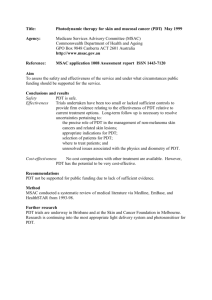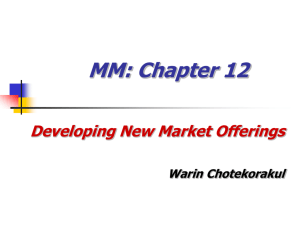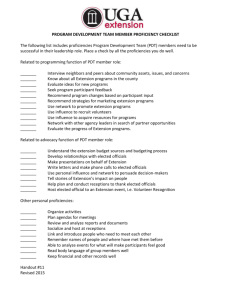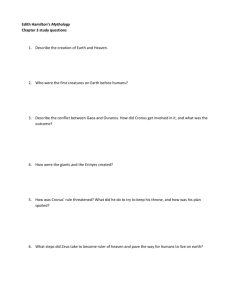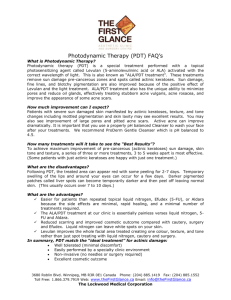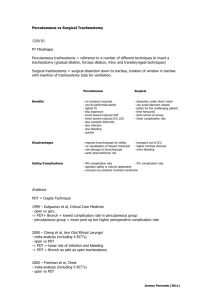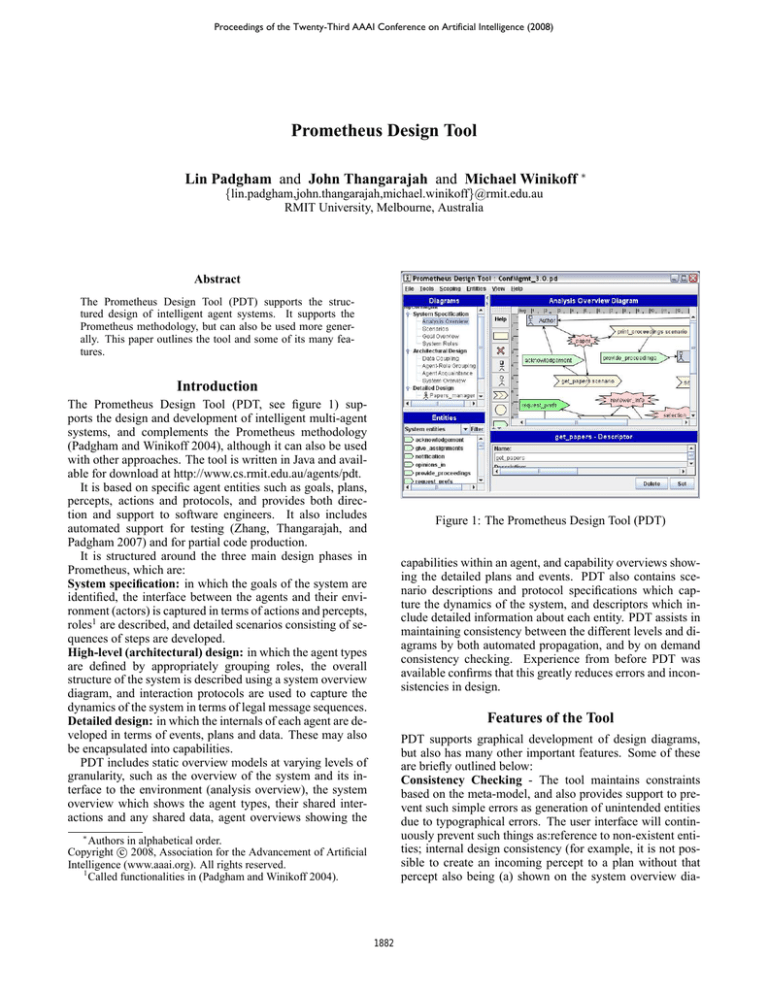
Proceedings of the Twenty-Third AAAI Conference on Artificial Intelligence (2008)
Prometheus Design Tool
Lin Padgham and John Thangarajah and Michael Winikoff ∗
{lin.padgham,john.thangarajah,michael.winikoff}@rmit.edu.au
RMIT University, Melbourne, Australia
Abstract
The Prometheus Design Tool (PDT) supports the structured design of intelligent agent systems. It supports the
Prometheus methodology, but can also be used more generally. This paper outlines the tool and some of its many features.
Introduction
The Prometheus Design Tool (PDT, see figure 1) supports the design and development of intelligent multi-agent
systems, and complements the Prometheus methodology
(Padgham and Winikoff 2004), although it can also be used
with other approaches. The tool is written in Java and available for download at http://www.cs.rmit.edu.au/agents/pdt.
It is based on specific agent entities such as goals, plans,
percepts, actions and protocols, and provides both direction and support to software engineers. It also includes
automated support for testing (Zhang, Thangarajah, and
Padgham 2007) and for partial code production.
It is structured around the three main design phases in
Prometheus, which are:
System specification: in which the goals of the system are
identified, the interface between the agents and their environment (actors) is captured in terms of actions and percepts,
roles1 are described, and detailed scenarios consisting of sequences of steps are developed.
High-level (architectural) design: in which the agent types
are defined by appropriately grouping roles, the overall
structure of the system is described using a system overview
diagram, and interaction protocols are used to capture the
dynamics of the system in terms of legal message sequences.
Detailed design: in which the internals of each agent are developed in terms of events, plans and data. These may also
be encapsulated into capabilities.
PDT includes static overview models at varying levels of
granularity, such as the overview of the system and its interface to the environment (analysis overview), the system
overview which shows the agent types, their shared interactions and any shared data, agent overviews showing the
Figure 1: The Prometheus Design Tool (PDT)
capabilities within an agent, and capability overviews showing the detailed plans and events. PDT also contains scenario descriptions and protocol specifications which capture the dynamics of the system, and descriptors which include detailed information about each entity. PDT assists in
maintaining consistency between the different levels and diagrams by both automated propagation, and by on demand
consistency checking. Experience from before PDT was
available confirms that this greatly reduces errors and inconsistencies in design.
Features of the Tool
PDT supports graphical development of design diagrams,
but also has many other important features. Some of these
are briefly outlined below:
Consistency Checking - The tool maintains constraints
based on the meta-model, and also provides support to prevent such simple errors as generation of unintended entities
due to typographical errors. The user interface will continuously prevent such things as:reference to non-existent entities; internal design consistency (for example, it is not possible to create an incoming percept to a plan without that
percept also being (a) shown on the system overview dia-
∗
Authors in alphabetical order.
c 2008, Association for the Advancement of Artificial
Copyright Intelligence (www.aaai.org). All rights reserved.
1
Called functionalities in (Padgham and Winikoff 2004).
1882
Related Work
gram, and (b) shown as incoming to the agent whose plan
it is); errors such as incorrect relationships between entity
types; violations of interface declarations (e.g. if an agent
is specified as reading a belief set, then it is not possible to
create an arrow from one of the agent’s plans to the belief set
indicating writing). In addition to the above run time check
there is also an on-demand check feature that generates a list
of errors and warnings that can be checked by the developer.
Further details are available in (Padgham, Thangarajah, and
Winikoff 2005).
Graphical interface plus structured textual descriptors The tool provides a direct manipulation graphical interface
for creating the key diagrams of the Prometheus methodology. There are also textual forms for entity descriptors
which allow a combination of free text and entries based on
menus of items.
Propagation - Wherever possible, information is propagated from one part of the design to another. For example,
if goals are associated with a role, and the role is associated
with an agent, then the goals are also automatically associated with that agent. Similarly, graphical icons representing
things that should be included in a particular diagram are automatically placed into that diagram. Whenever information
about an application entity is changed, it is propagated to all
relevant places in the design.
Hierarchical views - The tool allows for each agent to be
developed with as many layers of abstraction as needed to
keep each layer manageable in size. This is achieved using
capabilities and capability overview diagrams.2
Report generation - A much appreciated practical feature
of the tool is its ability to generate an (customizable) HTML
design document. This document contains both figures and
textual information, as well as an index over all the design
entities. The tool can also save printable images of the various diagrams (in PNG format).
AUML protocol specification - The designer may specify
AUML interaction protocols using textual notation via the
protocol editor in PDT. Specification in the protocol definition also introduces entities into the other relevant models.
Code generation - PDT currently provides a code generation feature that generates skeleton code in the JACK agent
language (www.agent-software.com.au). This can then be
completed by the developers. The tool supports repeated
code generation from the design, preserving any user edited
code segments.
Automated Testing - PDT supports automated generation
and execution of unit tests for testing of events, beliefs and
plans, based on the design model. User defined tests can be
added to those automatically generated. A test report is generated as a hyperlinked html document.
Auto save and Backup - PDT automatically saves the current project at a set time interval (which can be changed) and
also allows for creating backup files, which save the current
version into a different file specified by the user.
A number of other agent-oriented software engineering
methodologies have tool support including Tropos and OMaSE (see (Luck and Padgham 2008)) Tropos tool support,
consists of a number of separate tools that cover different aspects of the software engineering process. The closest tool to
PDT is TAOM4E3 . The O-MaSE methodology is supported
by agentTool4 . At the 8th Agent Oriented Software Engineering Workshop, held in May 2007, the developers of Tropos, agentTool and PDT presented their tools by demonstrating their use on a popular multi-agent system design case
study: a Conference Management System. Papers describing this can be found in the workshop proceedings (Luck and
Padgham 2008). The JACK Design Environment (JDE) 5 is
also related to our work, since it provides design diagrams.
However, the JDE does not support system specification activities or high level design. In addition PDT has some related tools, one of which supports debugging of agent programs based on design models (Padgham, Winikoff, and
Poutakidis 2005) and one which supports modifications by
application domain experts which can produce fully functioning code (Jayatilleke, Padgham, and Winikoff 2005)
Conclusions and Future Work
Prometheus and PDT try to strike a balance between structured well defined models, and flexibility that is required by
engineers. Ongoing work includes increasing the range of
automated testing, work on support for maintenance activities, integration with models of social organisation and tools
for defining these (Carles Sierra and Winikoff 2007).
We would like to acknowledge the support of Agent Oriented Software Pty. Ltd. and of the Australian Research
Council (ARC) under grant LP0453486.
References
Carles Sierra, John Thangarajah, L. P., and Winikoff, M. 2007.
Designing institutional multi-agent systems. In Padgham, L.,
and Zambonelli, F., eds., AOSE 2006, 84–103. Springer-Verlag,
LNCS.
Jayatilleke, G. B.; Padgham, L.; and Winikoff, M. 2005.
A model driven component-based development framework for
agents. Computer Systems Science & Engineering 4(20).
Luck, M., and Padgham, L., eds. 2008. Agent Oriented Software
Engineering VIII (AOSE’07), volume 4951 of LNCS. Springer.
Padgham, L., and Winikoff, M. 2004. Developing Intelligent
Agent Systems: A practical guide. Wiley Series in Agent Technology. John Wiley and Sons.
Padgham, L.; Thangarajah, J.; and Winikoff, M. 2005. Tool support for agent development using the Prometheus methodology.
In ISEAT 2005. IEEE.
Padgham, L.; Winikoff, M.; and Poutakidis, D. 2005. Adding
debugging support to the prometheus methodology. Journal of
Engineering Applications in Artificial Intelligence 18/2.
Zhang, Z.; Thangarajah, J.; and Padgham, L. 2007. Automated
unit testing for agent systems. In ENASE-07, 10–18.
3
http://sra.itc.it/tools/taom4e/
http://agenttool.cis.ksu.edu/
5
http://www.aosgrp.com/products/jack/index.html
4
2
A useful addition would be to also allow named subsystems of
agents.
1883

